Sewing machines, the cornerstone of textile craftsmanship, have evolved significantly over the years. From the hand-operated machines of the past to today’s computerized models, these devices have been instrumental in bringing our textile visions to life. But not all sewing machines are built the same. Some are perfect for light fabrics, while others are specifically designed for more challenging materials, like leather. In this article, we’re focusing on leather sewing machines, exploring the top picks for 2023 based on user experiences and feature sets. So, whether you’re a hobbyist or a professional, this guide will help you navigate through the vast sea of options available in the market.
1. SINGER 4432 – Best for Home Use

Pros:
- Durable design suited for long-term use.
- A diverse selection of stitches to cater to various projects.
- Handy built-in needle threader saves time.
Cons:
- Some users may find it a bit noisy.
- Might not handle very thick leather as smoothly as industrial machines.
Personal Experience Comments: The machine’s heavy-duty build is reassuring for consistent home use. It’s not just for leather but offers flexibility for other materials as well. The variety of stitches makes it ideal for creative projects.
2. SINGER 4423 – Best Entry-Level Leather Sewing Machine

Pros:
- Robust motor designed for sewing through thicker fabrics.
- Faster sewing speed for quicker project completion.
- A good number of stitches for an entry-level machine.
Cons:
- Some users report tension issues.
- Requires regular maintenance for optimal performance.
Personal Experience Comments: As an entry-level machine, it offers excellent value for money. It manages most leather projects for beginners and intermediates with ease. Its speed is notably impressive for its class.
3. Juki TL-2010Q – Best Premium Leather Sewing Machine

Pros:
- Precision stitching with single-needle lockstitch.
- Spacious working area for larger projects.
- Commercial-grade features yet still lightweight.
Cons:
- Price might be steep for hobbyists.
- May have a learning curve for beginners.
Personal Experience Comments: The machine feels like a bridge between home and industrial machines. Its performance on leather projects, especially bigger ones, is remarkable. It offers professional-quality results.
4. Juki DU-1181N – Best for Commercial Use

Pros:
- Triple-feed mechanism ensures consistent stitching.
- Can handle high-volume work with its high-speed stitching.
- Built specifically for heavy-duty tasks.
Cons:
- Not ideal for small or intricate projects.
- Can be overkill for casual hobbyists.
Personal Experience Comments: As a commercial-grade machine, it meets the demands of a professional setting, ensuring durability and speed. Its efficiency on leather, especially thick ones, is commendable.
5. Brother PQ1500SL – Best for Different Types of Leather

Pros:
- Versatile with both sewing and quilting capabilities.
- High-speed motor ensures faster project completion.
- Adjustable feed dog positions provide greater control.
Cons:
- Limited stitch selection compared to others.
- Might be a bit noisy for some.
Personal Experience Comments: Its adaptability to different leather types is a standout feature. The machine’s precision, coupled with its speed, makes for a rewarding sewing experience.
6. Brother ST371HD – Bonus Alternative

Pros:
- Robust stitching ideal for thicker fabrics.
- Offers a rich selection of stitches.
- Easy to move and store due to its compactness.
Cons:
- Might struggle with very thick leather pieces.
- The working space is relatively smaller.
Personal Experience Comments: Despite its compact size, it’s a powerhouse. Its versatility is notable, handling various materials beyond just leather. The portability is a plus for those with limited space.
7. Heureux Z6 – Bonus Alternative

Pros:
- A vast array of built-in stitches for versatile projects.
- Combines lightness with portability.
- Can be expanded for quilting and embroidery.
Cons:
- Being computerized, it might have a steeper learning curve for some.
- Repair and maintenance might be pricier.
Personal Experience Comments: It’s a delightful machine for those who enjoy tech integrations in their sewing. The breadth of stitches it offers gives creative freedom. Transitioning from traditional to computerized might take some time, but it’s worth the dive.
Best Sewing Machines for Leather – Buyer’s Guide & Tips
The most important thing to consider when choosing a sewing machine for leather is whether it can accommodate that thick material. You should also look at whether you need to buy any additional accessories. These sewing machines come in a range of prices, which is why it’s important that you know how much you can afford too. You’ll also want to look at the number of built-in stitches and included feet. Each foot allows you to do different types of projects, including adding a hem to clothing and creating buttonholes.
One of the reasons these machines work well on leathers is because of the powerful motors. You can use a foot pedal to increase and decrease your speed to work quickly on thick materials. The sewing machines are also compatible with the large needles necessary for leather work. As you look at the top sewing machines for leather, you’ll want to look for one that fits your craft budget and one that gets great reviews. Those reviews help you find the best of the best.
Sewing Machine Techniques
The two most important things to keep in mind when you’re sewing leather are, first, you need to have a leather needle for your sewing machine. A leather needle is shaped more like a chisel than a needle, and it’s designed to cut through the leather rather than push apart the weave of the fabric like a regular sewing needle does.
The second thing you need to bear in mind is that you don’t want to use all-purpose thread. You want to get yourself a good heavyweight upholstery thread, preferably in nylon if you can find it. That won’t react with the leather at all, and it will also stand up to much rougher treatment than regular thread.
Finally, to prepare your sewing machine, you need to make sure it’s oiled well, and make sure that your bottom bobbin compartment is completely clean because you’re going to make a big mess out of leather fibers and everything.
Video Guide: How to Sew Leather Using Sewing Machine?
Tip #1 – Reasonable Sewing Machine
You do need a reasonable sewing machine for leather. It’s got what’s called compound feed. That’s probably the number one thing. The challenge for a leather sewing machine is actually going across seams. It’s very difficult, because the foot if you think about it, is having to climb over the bump of a seam. At the same time, you have to pull the slippery leather through the transit mechanism. It’s quite a technical challenge.
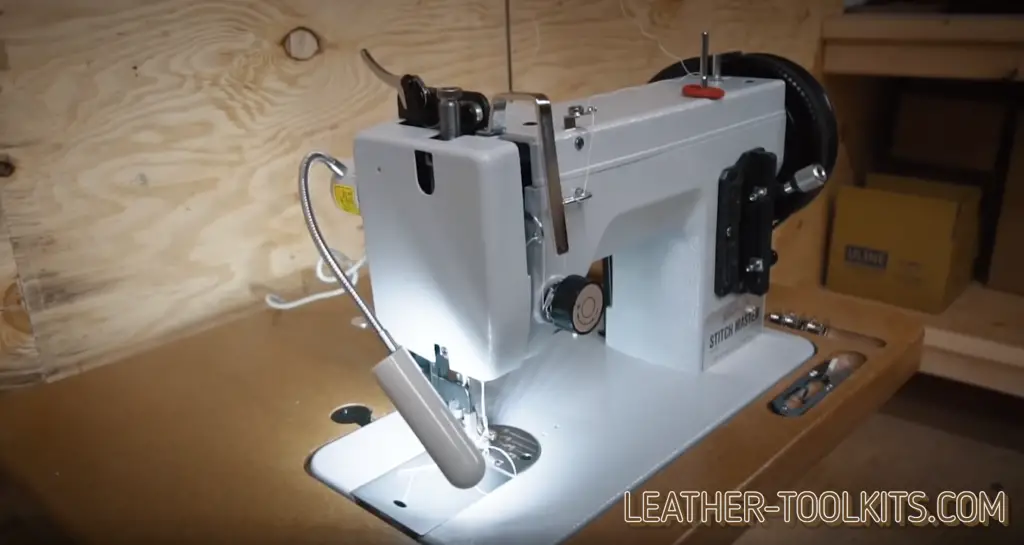
The key things really are to have what calling needle feed. It’s where the needle literally walks forward as it sews and pulls the slippery leather through. You have a good bottom feed, which does like an ovalized motion to drag the leather through, and you have like a walking foot which also helps to keep the leather down at the right point in the needle stroke. Also, again, helps to drag it all through. Compound feed machine, pretty essential if you’re doing precision stitching. Obviously if you’re just doing more things like ax covers, knife sheaths, a drop feed machine’s perfectly okay.
Tip #2 – Pick Right Size of Needle
You don’t want too big a needle. That’s the mistake a lot of people make when they first start using a sewing machine for leather. You also want to have the right size of thread. Again, there’s a tendency for people to overengineer and think that they must have a massively strong thread.
If you come from a woodworking background, you’ll probably know, if you put in one little tack into something, it’s easy to pull it out. It’s not terribly strong. If you put in a row of 10 tacks, it’s pretty strong, and it’s the same idea with sewing. One stitch on its own isn’t going to be very strong. A row of 10 stitches will be pretty tough. You can get away with actually using quite a fine thread. You can use what’s called bonded nylon thread, which is very good for machine sewing with leather.
You can use mostly size 40 in the European measures, and that’ll translate differently in the States. If you’re doing finer work, you can use the likes of a 60. If you’re doing a very heavy duty work, you may use a 20. The things to say about the thread, you want to have it that it’s strong enough. The best way actually is to try destroying the seam, and see what breaks first whether it’s the leather or the thread. You’ll obviously find that’s partly dependent on the closeness of your stitches. Err on the side where you can of using a finer needle and a finer thread.
Tip #3 – Well-Lit Surface
Make sure you’ve got a well-lit surface. You have to buy little magnetic lights, and little LED lights that run off the motor, and they’re really good. If you have a clutch motor, you can still get them. You can plug them in the mains. They just light up the sewing area. It gives you enough light to see clearly what’s going on. You can find that your accuracy increases by having very good light.
Tip #4 – Test Run of Stitches
Always to do a little test run of stitches to check your thread tension. What you’re looking for with thread tension is whether the stitches, they should form with their loops each side of your leather piece. You’re looking to see whether they form evenly with the loops forming in the center of two bits of leather. You don’t want the loops just forming on the top or on the bottom only.
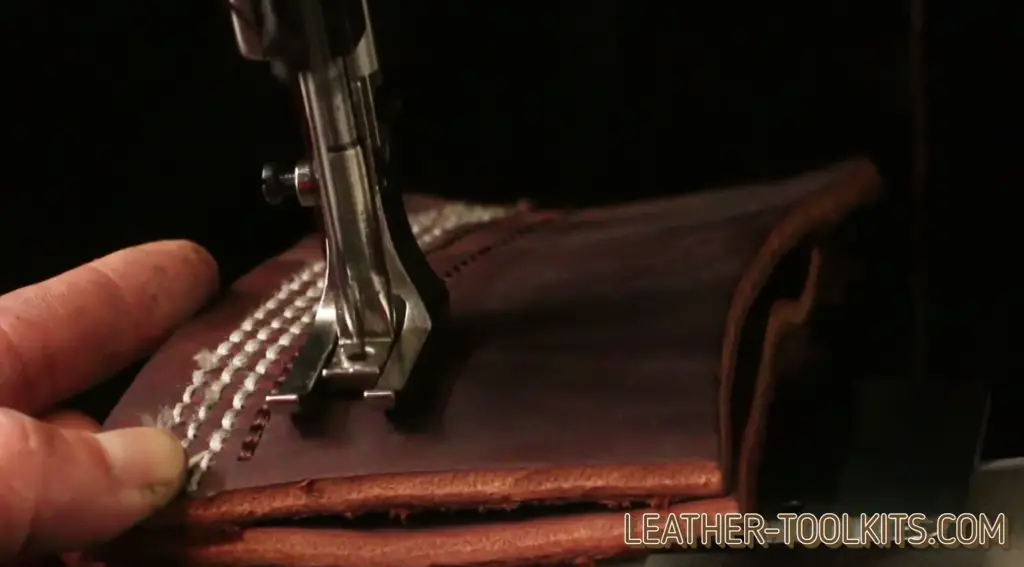
Essentially, what you’re doing is you’re adjusting the tension dial on your sewing machine if you find that it’s wrong. The loops are forming underneath the two bits of leather, so one thread is going like a straight line, and the top bit is going with huge loops right the way through both layers of the leather. It’s not going to be a very good or very strong or very neat seam.
Make a little adjustment on the tension knob, and that will pull the thread back up and get the loop in the center of the two bits of leather. Sometimes you have to adjust a bobbin tension, and you can do what’s called a drop test for that.
Tip #5 – Keeping Bits of Leather
The tip is about how you can keep your bits of leather closely aligned up while you’re sewing. You can’t pin the leather normally. You really got a couple of options. You can use little plastic patchwork workers clips and just go around clipping your bits of leather. Then as you come to sew, you can take the clips off. That’s one option. Some people use double-sided tape, which is quite effective.
Another option is to use some fairly fast-setting leather glue. You can go round your seam, line up your two pieces. Done this a bit crudely, but hopefully, you can see the idea. Then just press them into shape. Where you get the glue splurging out, wipe it off. That dries in literally a few minutes, but it’s quite a good way for holding delicate leather shapes if you want to keep them aligned nicely.
Tip #6 – Getting a Nice Accurate Stitch Line Right Up to Your Edge
The best way to do this is by one of these adjustable edge guides. You can adjust them both up and down. They have a little roller wheel, and they make sure that your stitches line up nicely against your edge. If you’re going around a curve, for example, you get an excellent alignment.
Tip #7 – Adjust Your Stitch Size
If you think about it, if you were doing this corner with large stitches, it would actually be quite difficult to control the sewing machine as you’re going around the corner. Because with large stitches, your sewing machine is running faster. You’ve got less time to control that curvature. If you take the stitch size down, so they’re quite small stitches, it’s like walking around. It’s far slower. People don’t think about it, and It does make a huge difference. It may just come intuitively to you, but it’s worth bearing that in mind. Take the stitch size down. It gets a lot easier to control it.
Tip #8 – Practice on Scrap
The more you try sewing something, practice on scrap, the better you’ll get. You’ll get better quite quickly. It’s surprising. If you’re doing shapes and curves which one has to do quite a lot in leather work, it’s worth keeping a certain speed and rhythm going. If you go too slowly on doing a curve, it can start to look a bit stilted. Whereas if you move fairly smoothly and quickly, the answer is being smooth the whole time. If you’re fairly smoother with your sewing machine, you’ll get excellent good-quality stitching.
Tip #9 – Hammer Your Stitches Down
It does pay to hammer your stitches down. They’ll look so much neater. You just have a plastic hammer, nylon hammer, an anvil, and go along. What you’re doing is you’re bedding those stitches down into the leather. Do it both sides, particularly on the reverse side it’s worth doing. It just sinks the stitches right down and makes it neater. It also will probably make them last longer because they get a bit more buried into the leather. It’s worth doing that. You’ll be amazed at the difference.
Tip #10 – Trim Loose Ends
If you’ve got loose ends, you can trim them. You can use little snips for this. What is also quite a good idea, if you’ve got a tiny little end like a two or three-millimeter end, you can burn it off. It puts a little ball on the end and stops it from getting dragged through. Obviously, when you’re stitching a seam, you go back on your stitches four or five stitches to lock them in. In addition to that, if you burn off the ends with a lighter if it’s bonded nylon, you can do it and it looks very neat. It gets rid of the loose end, puts a little ball on which can’t be seen, and locks that stitch even more so. Another little tip worth bearing in mind.
How to Use a Walking Foot Attachment
Walking foot has feed dogs, these little teeth, that move up and down with the feed dogs that are on your sewing machine. This is what pulls the leather or fabric through the machine.
When you’re doing regular sewing with any other regular foot, there are no feed dogs on top. But sometimes, you want something pulling that top fabric along with your bottom material. It’s great for quilting when you’re sewing lots of layers of thick fabric, and it’s also good if you’re stitching thick, slippery materials, like vinyl or leather.
How to Install a Walking Foot
To install the walking foot on a sewing machine for leather, you have to make sure that the presser shank is up, and then you have to unscrew the screw, and you will see that the shank fell off, that’s fine. Put that aside. And with the walking foot, you want to make sure that your needle is a little bit low. Your screw that attaches that holds your needle in this area corresponds with this lever that’s on the walking foot.
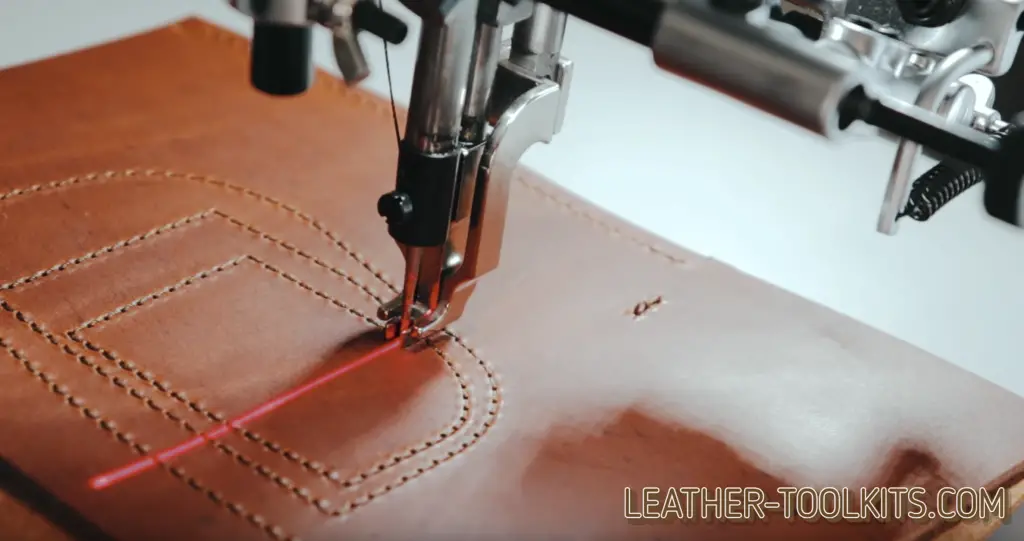
So, when you install this, you’re going to make sure this lever is on the right, but you want it to sit on top of this screw that holds your needle in. So, you have to put that in, and this is resting on there. And then you can take your screw, and put your screw in to hold the foot and tighten it, so everything is secure. If you have a screwdriver, you can use it. Now you can rotate the wheel to bring the needle back up, and you will see, as the needle comes up and down, this lever is resting on this piece and moving with the needle. And so, that’s what controls these upper feed dogs.
Once you have your walking foot installed, let’s go ahead and try it.
FAQ
Can you use regular sewing machine for leather?
There are ways to use a regular sewing machine and work with leather. However, you probably need a heavy duty machine or one made for thick fabrics.
The biggest issue with leather is that there are no do-overs, and the fabric is likely to stretch unless you use a different foot.
For those who work with sewing machines and leather regularly, a a walking foot is recommended. This is because leather is very thick and also slick to run over with the needle. With a walking foot, your needle walks over your fabric, so that it doesn’t stretch.
In other cases, professionals recommend using a Teflon non-stick foot. These are presser foots that fit all low shank snap-on style sewing machines.
You’ll also need to use a leather needle and change them so that they are always pointy and ready to push through thick leather fabric. These needles will leave distinctive holes in your fabric so you don’t want to use them in any other case.
Using clips is preferable to using pins when sewing with leather as well. You can use patternweights or scotch tape when cutting out different pattern pieces too.
Which is the best sewing machine for sew thick material and leather?
When you try to sew thick fabrics, you’ll need a leather sewing machine that has a pointy, heavy duty needle and a shorter throat to allow for leather to move freely through the needle. The throat on a typical domestic sewing machine is 9 inches or less.
Janome heavy duty sewing machines for leather are known for their ability to handle multiple layers of fabric, and it has an adjustable foot presser and free arm capabilities. Singe Heavy Duty 4423 Sewing Speed Machine is another top choice for those who want a powerful motor that can handle multiple layers or thick leather.
In addition, heavy duty sewing machines are typically larger and attached to tables. These are designed to sew quickly and handle thick layers of cotton fabric and leather. Regular sewing machines are made for home use and have a slower sewing speed, and they aren’t able to handle leather as well as a larger machine with a better motor. For example, the Janome heavy duty sewing machine can run at a top speed of 860 stitches per minute.
What kind of thread is used for leather?
Before you start any leather sewing project, you’ll need to find thread that matches the type of leather fabric you’re working with. When you sew leather on a sewing machine, your stitches have to be short enough to create a tight seam, but they shouldn’t be so shot that the leather is weak or stretched from so many perforations.
Bonded nylon is probably the best leather for sewing leather. It also has different weights that work with the specific thickness of the leather you’re sewing. It adds strength to your garments and reduces friction as well, enabling your machine to smoothly create stitches at a faster speed. It’s also a good option for hand sewing leather when you need to create special stitches.
For example, bonded nylon #92 thread is recommended for thicker, stiff leather that weighs between 3 and 5 ounces. This is a thicker weight of thread and will bear a load, since you are likely working with boot leather. If going for thicker leather for furniture, then there’s a #138 weight that matches that type of thick fabric too.
Generally, as the bonded nylon thread count goes higher, the thread is much thicker to match the thickness of your leather garment. The thread counts go up to over #277 and can be used for leather up to 12 oz or thicker.
What size sewing machine needle should I use for leather?
There are specific needles for sewing leather that have different sizes as well. Since leather comes in different thicknesses, it’s important to pick a leather needle that matches the same fabric weight. Since leather ranges from 2 oz to over 12 oz in weight, you’ll find several leather needle sizes are available.
A 4 oz piece of leather equals 1/16” thick. An 8 oz piece of leather is 1/8″ thick. As the weight gets heavier, the leather is also thicker, which requires a sturdier, pointier needle to match. The leather needle has a cutting point, which looks like an arrowhead. These needles are designed to penetrate any type of leather, but they may not work well with highly synthetic leather. This leather requires a softer point because it could tear with too much stress.
Since there are a variety of needle sizes out there, you’ll find a vast selection with leather needles specially. Sizes of leather needles include, from smallest to largest in thickness:
- 70/10
- 80/12
- 90/14
- 100/16
- 110/18
One of the best needles to use for thick leather is the R point Groz-Beckert needle, but the weight of the fabric should be 4 ounces or lower. A cutting point needle works well for thicker pieces of leather, if you prefer. These needles have a special shape and point, which is designed to slice and puncture fabric without any resistance. If you are embellishing and stitching thick leather, then you can use the cutting point needle.
What is bonded thread?
When working with thicker fabrics like leather, you can’t use the same thread as you would with cotton or even denim fabrics. In addition, fabrics have different weights, and leather can also be thicker and quite stiff. For this reason, bonded thread is the best option for sewing thick fabrics.
Bonded nylon thread works well for thicker fabrics. When sewing upholstery, leather fabrics, thick cotton, and quilts, then bonded thread is a better option. This is because it’s coated in resin and strengthened to decrease the amount of friction as you thread and sow.
There are thicker thread counts for all types of thread, but bonded thread will be marked as such. There are two types of bonded thread:
- Bonded nylon
- Bonded polyester
You should use bonded nylon for leather, and you can purchase it in different weights to match the thickness of the leather. You should also note that it can’t be exposed to UV rays or light for very long as it will likely discolor and fade. As a bonding agent, it helps to stitch leather smoothly without stressing or stretching it. In addition, bonded nylon is available in different thread counts and thickness sizes, ranging up to #277. This is helpful if you are working with very hard, stiff leather, such as with furniture.
With bonded polyester thread, thread is strengthened and resistant to UV rays, but it’s not as durable as bonded nylon. It’s still a good option for heavy duty stitching projects and thick pieces of leather.
What is an 80/12 needle used for?
There are fine, medium, and heavy duty needles. An 80/12 or 12/80 needle is a medium to thick needle that you’ll commonly work with if stitching thick leather and other multi-layers of fabric.
Medium needles range from 11/75, 12/80, to 14/90. However, the 12/80 needles are also used for denim sharp needles, top-stitch, metallic, and microtex needles, as well as leather needles.
Leather needles are much different in shape. These are wedge-shaped with a razor-sharp knife edge that can puncture leather and vinyl without ripping it. The hole is smooth and neat due to the sharpness and design.
What is a 70 10 sewing needle?
Needles also have different points and sizes. Leather needles use a sharp or wedge point. A 10/70 sewing needle is available for sharp and universal points. These are typically a bit more fine for leather, so you’ll want to work with a smaller weight of leather such as a 4 oz.
A 10/70 sewing needle is also available for a denim sharp needle, microtex, and fine needle types.
What is the difference between a ballpoint needle and a stretch needle?
Typically, ballpoint and stretch needles won’t work well with leather fabrics. You’ll use a ballpoint needle for heavier, looser fabrics, such as knits. Stretch needles are used for highly elastic fabrics, such as Spandex or Lyra.
These points have rounded ends that puncture between the fabric thread rather than piercing through. Stretch needle points aren’t as rounded as ballpoint points.
Leather needles have a cutting point that looks like an arrowhead in some cases. These points cut right through thick leather, but if it’s a highly synthetic leather, you may want to use a stretch point rather than a genuine leather needle. This is because synthetic leather tends to stretch and tear with cutting points.
Sources:
Sewing Machine (Wikipedia)
How to Sew Leather With a Standard Sewing Machine
Leather Sewing Machines (Leatherworker)


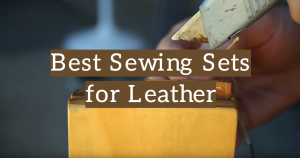
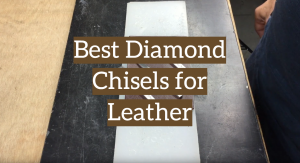
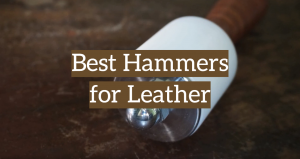
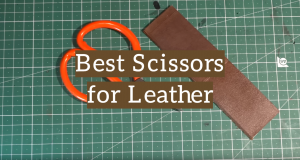
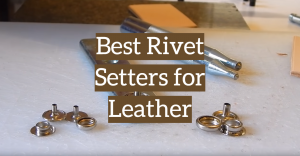
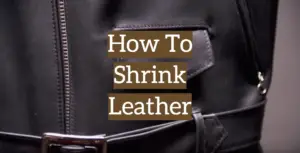
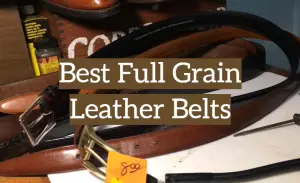

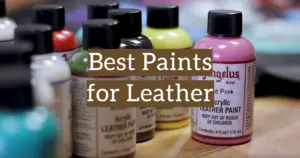

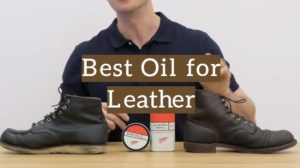


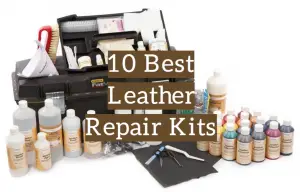
Loving working with the Brother CS600i. It’s super smooth and I’ve never had a problem with the tension dropping like your con list states. Unless it starts to happen once it gets older. I’ve only had the machine for a few months.
I purchased the Brother ST371HD and I am absolutely in love with it. I do think you’re right about the lighting but with a lamp, it makes it fine. The stitching options are phenomenal and it’s easy to transport.
The option to choose which stitch to use on the screen on the Singer Quantum is to die for! It makes my sewing so much quicker, and I can make more intricate designs in almost no time.
Hello, Kailey! Thanks for your comment. I absolutely agree with you, It is the quickest sewing machine if you want to sew leather!
The brother sewing machine supposedly comes with an instructional video but when I received mine it was definitely not in the box. Is there a way to access it online or get a new one from the company?
Hello, Darien! Thanks for your comment. You can watch video instructions on the brother official website. There are a lot of useful videos about using their sewing machines.
I’ve never sewn leather before but I am looking at getting into making my own clothes. Would you suggest getting one of these machines in order to make the process of creating clothes easier?
Hello, Marshall! Thanks for your comment. I would recommend you Singer Quantum Stylist 9960. In my opinion, it’s the best sewing machine for leather.
I didn’t realize the Janome needed a special needle for leather. I tried to sew something, be it was very thin, and totally broke part of the machine. Does their warranty cover that? Haha, I think I just need to buy a new one.
Hello, Jeremy! I would recommend buying a Singer Quantum Stylist 9960, because it’s a very durable sewing machine.
I have only ever hand stitched leather. Investing in a quality machine would allow me to work faster and more efficiently. None of these machines look too expensive. I might need to consider investing in one come the holiday season and before my next project. Thanks for sharing this article!
Hello, Raven! Thanks for the comment.
Is the Brother XL-3022 capable to sew leather materials?
Hello, Otis! I’m not sure. I’d recommend to look at Brother CS6000i. I use it now and it sews leather perfectly.
I have a sewing machine for leather that is years old. Fortunately it is still up to the challenge with each new project I throw at it. A built-in free arm was a nice feature for me and one I’ll insist on having with any replacement – which I hope isn’t needed soon!